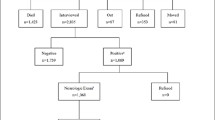Abstract
Current epidemiologic data on the association between environmental factors and essential tremor (ET) are scanty. In a population-based case-control study we investigated the relationship between some putative risk factors and ET. In the present study, we included all subjects identified during a door-to-door prevalence survey in a Sicilian community, affected by ET, and alive on 1 November 1987 (n=31). Of the 31 prevalent cases of ET, we were able to contact 28 subjects. Twenty-eight controls were randomly selected from the general population and matched to each case for age and sex. Exposure variables were investigated by interviewing the patients and their controls or close relatives, using a structured questionnaire. The odds for habitual alcohol consumption were 0.3, indicating a protective effect. The odds for exposure to agricultural chemicals and domestic animals were 2.5 and 2.7, respectively, suggesting a role as potential risk factors. However, the associations found by us were not statistically significant.
Sommario
Un argomento poco considerato dalle indagini di epidemiologia analitica riguarda la possibile influenza di fattori di rischio ambientali sull'eziologia del tremore essenziale. Scopo del presente lavoro è quello di verificare l'esistenza di un'associazione tra possibile fattori di rischio e il tremore essenziale, attraverso uno studio caso controllo su popolazione. In un precedente studio di prevalenza di tipo porta a porta, abbiamo identificato tutti i pazienti affetti da tremore essenziale residenti net comune di Terrasini net giorno di prevalenza, 1 Novembre 1987 (n=31). A 28 di tale pazienti e a un gruppo di controloi di uguale numerosità, selezionati dalla popolazione generate e appaiati per età e sesso net rapporto di 1:1, è stato possibile somministrare un questionario strutturato, per valutare l'esposizione a diverse variabili ambientali. Il rischio per it consumo abituale di alcool è risultato di 0,3, suggerendo un effetto protettivo per tale assunzione; al contrario l'esposizione ad anticrittogamici e il contatto abituale con animali domestici hanno mostrato rispettivamente un rischio di 2,5 e 2,7, valori questi the candiderebbero tali esposizioni come fattori the aumentano il rischio di sviluppare it tremore essenziale. Nessuna di tale associazioni è comunque risultata statisticamente significativa.
Similar content being viewed by others
References
Critchley MD (1949) Observations on essential (heredofamilial) tremor. Brain 72:113–139
Tanner CM (1991) Epidemiology of movement disorders. In: Anderson DW (ed) Neuroepidemiology: A tribute to Bruce Schoenberg. CRC, Boca Raton, pp 193–216
Findley LJ, Koller WC (1987) Essential tremor: A review. Neurology 37:1194–1197
Higgins JJ, Pho LT, Nee LE (1997) A gene (ETM) for essential tremor maps to chromosome 2p22-p25. Mov Disord 6:859–864
Gulcher JR, Jonsson P, Kong A et al (1997) Mapping of a familial essential tremor gene, FETI, to chromosome 3813. Nat Genet 17:84–87
Danek A (1993) Geniospasm: Hereditary chin trembling. Mov Disord 8:335–338
FitzGerald PM, Jankovic J (1991) Orthostatic tremor: An association with essential tremor. Mov Disord 6:60–64
Rosenbaum F, Jankovic J (1988) Focal task-specific tremor and dystonia: Categorization of occupational movement disorders. Neurology 38:522–527
Geraghty JJ, Jankovic J, Zetusky WJ (1985) Association between essential tremor and Parkinson's disease. Ann Neurol 17:329–333
Bain PG, Findley LJ, Thompson PD et al (1994) A study of hereditary essential tremor. Brain 117:805–824
Louis ED, Ottman R (1996) How familial is familial tremor? The genetic epidemiology of essential tremor. Neurology 46:1200–1205
Salemi G, Savettieri G, Rocca WA et al (1994) Prevalence of essential tremor: A door-to-door survey in Terrasini, Sicily. Neurology 44:61–64
Grigoletto F, Anderson DW, Rocca WA et al (1994) Attrition and use of proxy respondents and auxiliary information in the Sicilian neuroepidemiologic study. Am J Epidemiol 139:219–228
Meneghini F, Rocca WA, Grigoletto F et al (1991) Door-todoor prevalence survey of neurological diseases in a Sicilian population: Background and methods. Neuroepidemiology 10:70–85
Meneghini F, Rocca WA, Anderson DW et al (1992) Validating screening instruments for neuroepidemiologic surveys: Experience in Sicily. J Clin Epidemiol 45:319–331
Stolley PD, Schlesselman JJ (1982) Planning and conducting a study. In: Schlesselman JJ (ed) Case-control studies. Design, conduct, analysis. Oxford University, New York, pp 69–104
Rosner B (1988) Hypothesis testing: Categorial data. In: Rosner B (ed) Fundamentals of biostatistics. PWS Kent Publishing, Boston, pp 318–397
Schlesselman JJ (1982) Basic methods of analysis. In: Schlesselman JJ (ed) Case-control studies. Design, conduct, analysis. Oxford University, New York, pp 209–212
Nelson LM, Longstreth WT Jr, Koepsell TD et al (1990) Proxy respondents in epidemiologic research. Epidemiol Rev 12:71–86
Pickle LW, Brown LM, Blot WJ (1983) Information available from surrogate respondents in case-control interview studies. Am J Epidemiol 118:99–108
Sackett DL (1979) Bias in analytic research. J Chronic Dis 32:51–68
Schlesselman JJ (1982) Sample size. In: Schlesselman JJ (ed) Case-control studies. Design, conduct, analysis. Oxford University, New York, pp 144–170
Rajput AH, Oxford KP, Beard CM, et al (1984) Essential tremor in Rochester, Minnesota: A 45-year study. J Neurol Neurosurg Psychiatry 47:466–470
Wong GF, Gray CS, Hassanein RS et al (1991) Environmental risk factors in siblings with Parkinson's disease. Arch Neurol 48:287–28925
Ben-Shlomo Y (1996) How far are we in understanding the cause of Parkinson's disease? J Neurol Neurosurg Psychiatry 61:4–16
Author information
Authors and Affiliations
Rights and permissions
About this article
Cite this article
Salemi, G., Aridon, P., Calagna, G. et al. Population-based case-control study of essential tremor. Ital J Neuro Sci 19, 301–305 (1998). https://doi.org/10.1007/BF00713856
Received:
Accepted:
Issue Date:
DOI: https://doi.org/10.1007/BF00713856




